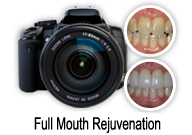CAT Scans for Implants, Periodontal Disease and Diagnosis
Technological advancements have played a pivotal role in improving diagnostic capabilities and treatment planning in dentistry. One such technology is the CT scan, also called the Computed Tomography scan. Keep reading to get answers to your frequently asked questions about CT scans and CAT scans when it comes to oral health.
What Is the Difference Between a CT Scan and a CAT Scan?
The terms “CT scan” and “CAT scan” are often used interchangeably, and in reality, they refer to the same medical imagining technique. Both terms stand for “Computed Tomography,” which is a diagnostic imaging procedure that uses X-rays and computer processing to create detailed cross-sectional images of the body.
Historically, “CAT scan” (Computerized Axial Tomography) was the original term used when the technology was first introduced in the 1970s. Over time, the term evolved to “CT scan” (Computed Tomography), which is more commonly used today. The change was made to reflect the broader range of imaging capabilities beyond just axial (cross-sectional) images.
There is no substantial difference between a CT scan and a CAT scan. They both refer to the same imaging technique that allows healthcare professionals to obtain detailed and three-dimensional images of internal structures within the body. The transition from “CAT scan” to “CT scan” reflects a linguistic shift rather than a change in the underlying technology or its applications.
Why Are CAT Scans Taken for Implants and Periodontal Disease and Diagnosis?
High-resolution CAT scans are very useful in detecting and monitoring the presence of oral diseases that are not easily uncovered by ordinary diagnostic procedures. CAT scans deliver detailed three-dimensional images of the patient’s mouth and its underlying structures so that dentists can examine all the different angles, including the location of nerves and sinuses, and incorporate their findings into an efficient treatment plan.
Optimal viewing of the bone that results from a CAT scan is often used to facilitate the insertion of implants and has also been a very useful tool prior to performing oral surgery because it helps dental surgeons avoid serious complications. CAT scans have also helped dentists identify cysts and tumors in the oral cavity.
Before the CAT scan advancement in dentistry, patients’ jaws were originally evaluated using ordinary radiographs. This procedure, however, did not give the dentists the full range of imagery that they needed to properly evaluate the condition of the patient’s mouth. It is safe to say that the CAT scan has revolutionized the way that dentists prepare for implant surgery, assess periodontal diseases, and formulate diagnoses based on the actual condition of the patient’s oral structures.
What Is the Importance of CAT Scans for Implant Dentistry?
Dentists and dental surgeons have found that the use of CAT scans was very useful in preoperative evaluation to determine whether the patient has sufficient bone mass in the jaws to accommodate dental implants. They were not able to get enough information using conventional radiography, and using CAT scans resolved this for them. CAT scan results not only show the exact location of the mandibular nerve but also other vital structures, such as the maxillary sinuses and incisive foramen, that need to be avoided during implantation to avoid serious complications.
What Is the Importance of CAT Scans for Periodontal Disease and Diagnosis?
CAT scans have also given dentists the opportunity to assess tumors, cysts, inflammatory diseases, and oral fractures that are not easily picked up by conventional radiography. They provide accurate information about the location of important structures in the mouth and precise details about internal oral anatomy that help the dentist formulate working diagnoses by establishing the relationship between the lesions, the condition of the jaw, and the oral structures.
Is a CT Scan Necessary for Tooth Extraction?
Tooth extraction is a dental procedure, but in certain cases, a CT scan may be deemed necessary. A CT scan provides a three-dimensional view of the oral structures, allowing dentists to asses the tooth’s position, root structure, and proximity to surrounding tissues. This detailed information aids in planning a safe and precise extraction, especially when dealing with impacted or complex cases. The CT scan helps dentists identify potential complications, such as proximity to nerves or sinuses, ensuring a smoother and safer extraction process.
Why Would an Oral Surgeon Do a CT Scan?
Oral surgeons often choose to utilize CT scans due to their ability to provide a comprehensive understanding of the oral and maxillofacial structures. These scans offer detailed images of bones, teeth, nerves, and soft tissues. This enables oral surgeons to plan complex procedures with precision. Whether it’s planning for dental implants or jaw surgeries or assessing the extent of pathology, a CT scan is a valuable tool that enhances the surgeon’s ability to navigate intricate anatomical structures.
Does a CT Scan Show Dental Infection?
Yes, CT scans are effective in revealing dental infections, even in their early stages. While traditional dental X-rays focus on capturing a two-dimensional image, CT provides a three-dimensional view, offering a more comprehensive assessment. In cases of dental infections, CT scans can identify abscesses, bone loss, and the spread of infection to surrounding tissues. This level of detail aids dentists and oral surgeons in formulating appropriate treatment plans, whether it involves root canal therapy, surgical intervention, or other targeted treatments.
Get Your Dental CT Scan Today!
CT scans have undoubtedly revolutionized the field of dentistry by providing practitioners with a powerful tool for accurate diagnosis and treatment planning. From aiding in tooth extractions to assisting oral surgeons in complex procedures and detecting dental infections, CT scans have become an invaluable asset in ensuring optimal oral health outcomes. As technology continues to advance, the integration of CT scans into routine dental practices will likely become even more widespread, ushering in a new era of precision and efficiency in dental care.
If you’re ready to transform your smile and prioritize your oral health, schedule a consultation in Springfield, MA, with Taylor Street Dental today! Regardless of whether you need a CT scan or just a routine checkup, the dentists at Taylor Street Dental can help you take the first step toward a healthier and more confident smile.





